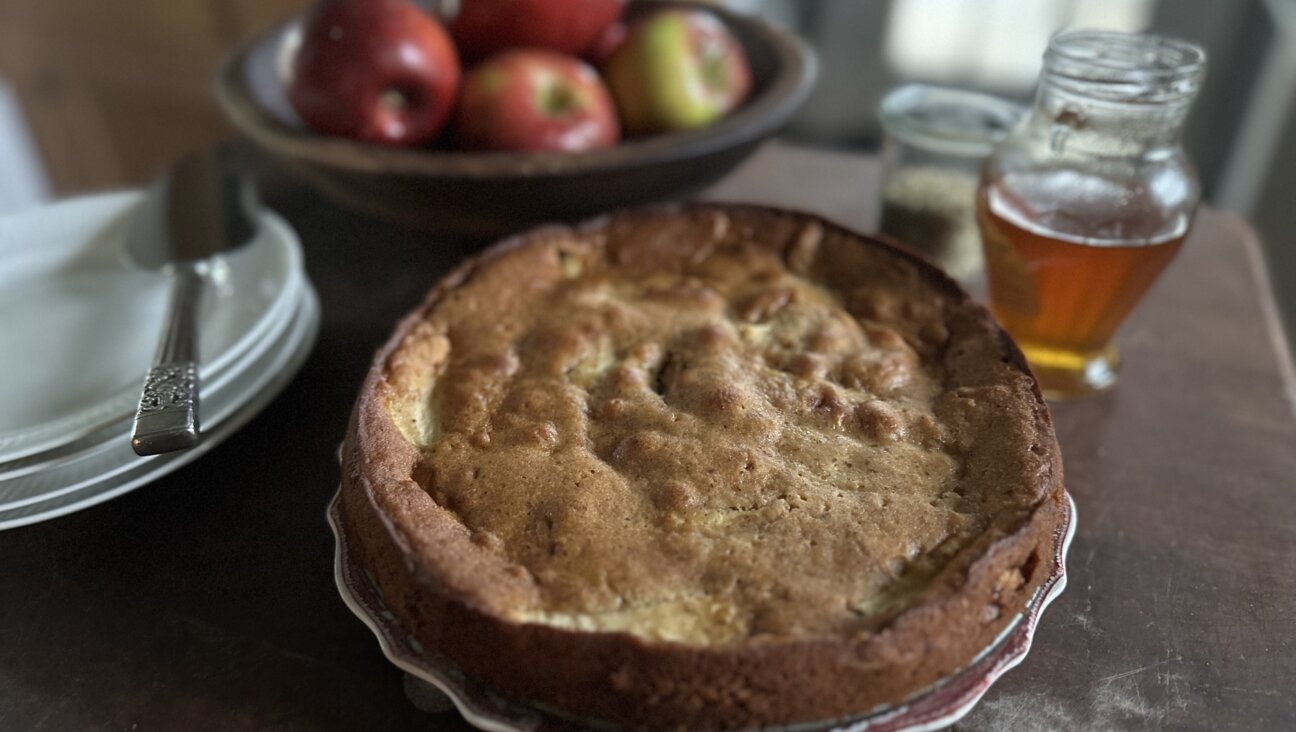Bringing a World of Mezze to Your Table

Image by Katherine Martinelli
Mezze — a brightly colored selection of dips, salads, olives and pickle vegetables — is ever-present on the Israeli table, both at restaurants and in the home. Much like the small bowls of salads and cheeses that accompany the Israeli breakfast, a variety of mezze will crowd a table along with the requisite breads to soak them up. The spread could easily be a delicious meal unto itself, but it is most often served as an appetizer or first course. The requisite sharing, reaching, and dipping has a convivial feel and serves as a conversation starter. Best of all, because most of the items are simple and greatest made ahead of time, any home cook can easily replicate the delicious tradition.
As with so many Israeli customs and foods, mezze brings together multiple culinary traditions, including Lebanese, Syrian, Persian, Moroccan and Turkish. In the “Encyclopedia of Jewish Food,” author Gil Marks traces the mezze tradition to ancient Persia, where the wealthy threw lavish parties and offered lots of little dishes to their guests to help soak up the alcohol. The Ottomans were responsible for spreading this tradition throughout the region. In Israel, bits and pieces from all of the mezze-loving countries have been adopted and absorbed into the culinary cannon for a spread all its own.
There are many components to a full mezze array, and it’s easy to mix and match. Typically six or more small dishes are served at once, along with pita or laffa, a Lebanese or Iraqi flatbread. Unlike breakfast, which is usually dairy, dinner in Israel is often a meat meal and so the vast majority of mezze are conveniently pareve. Mezze also often makes up a dairy lunch meal, in which case a selection of soft white cheeses and yogurt dips are enjoyed.
Often the same ingredient will show up in multiple incarnations with completely different textures and tastes. In “The Foods of Israel Today” author Joan Nathan declares Israel “the eggplant capital of the world,” and nowhere is that more apparent than in the variety of eggplant mezze. Baba ghanouj, a Lebanese eggplant and tahina dip, is probably the best known world-wide. An Israeli invention, salat hatzilim is a smoky, creamy combination of charred eggplant, garlic and mayonnaise that is downright addictive. Eggplant caviar (a dip of grilled, pureed eggplant) is another favorite, but with dubious origins – everyone from the Israelis to the Italians, and the Ukrainians to the French, claim it as their own.
Despite the prevalence of eggplant, a mezze assortment cannot be composed of eggplant alone (although some may argue with this). Tomatoes are another common flavor. Turkish salad, which is more sauce than salad, is made with pureed tomato, onion, red pepper and tomato paste and then is chilled. Matboucha is a Moroccan alternative that uses similar ingredients, but calls for them to be simmered together.
Another Moroccan mezze staple is carrot salad, which mixes sliced, cooked carrots with lemon, cumin and other (often hot) spices for a piquant starter. Pickled vegetables often accompany the mix of dips, but rarely are they cucumbers. Pickled carrots, beets, cauliflower, and more add a slightly sour crunch to the mezze selection. Hummus and tahina dip also make regular appearances in the rotation, as do green olives. Vegetables stuffed with rice or meat are less common, but do occasionally make an appearance, particularly when the mezze is being eaten as a meal.
Mezze is a great addition to any home cook’s repertoire. They rely on simple, quality ingredients that are full of flavor and are best prepared ahead of time. As Janna Gur advises in “The Book of New Israeli Food,” “Laying a truly magnificent meze [sic] table is not so difficult since nearly all the dishes are made ahead and you can always complement the selection with a few purchases: olives, a slab of feta cheese, pickled cucumbers and stuffed vine leaves.” Most mezze not only require that you allow them to sit either at room temperature or in the refrigerator for at least an hour or overnight, they improve when they are made in advance, giving the flavors extra time to meld. Whether entertaining on a weeknight or hosting Shabbat dinner, recipes like these can be lifesavers and are sure to impress your guests.
Moroccan Carrot Salad
Yield: 4 to 6 side/appetizer/mezze servings
6 carrots, peeled
2 cloves garlic, minced
1 teaspoon chili powder or cayenne pepper
3 tablespoons freshly squeezed lemon juice
1 teaspoon ground cumin
½ teaspoon hot paprika
¼ cup chopped cilantro or parsley
½ to 1 teaspoon harissa or chopped chili pepper (optional)
Salt
1) Cook the carrots in boiling water until just tender, about 10 minutes.
2) Drain the carrots and rinse under cold water. Slice on a bias into thin coin-shaped slices.
3) Mix together the garlic, chili powder, lemon juice, cumin, paprika, parsley, and harissa (if using) and toss with the sliced carrots. Season with salt.
4) Let stand at room temperature or in the fridge at least 1 hour, or in the fridge up to 2 days (the carrots will only get more flavorful with time). Serve cold or at room temperature.
Baba Ghanouj
Yield: About 2½ cups
2 large eggplants (about 2 pounds)
2 tablespoons olive oil (if cooking eggplant in oven or broiler)
½ cup tahina
3 tablespoons freshly squeezed lemon juice
3 cloves garlic, minced
1/8 cup chopped parsley or cilantro
Dash chili powder or cayenne pepper
Salt
1) Prepare the eggplant: ideally the eggplant should be cooked directly over an open flame until charred. This can be done over an open flame on a gas stove or on a grill. For those of us who must rely on electric stoves or who don’t like open flames, the broiler is your next best option. To cook in the broiler, cut the eggplants in half lengthwise, brush with olive oil, and lay face down on a baking sheet. Broil until charred.
2) Remove the eggplant from the flame or broiler and allow to cool. Scoop out the pulp and blend in a food processor.
3) Pulse or stir in the tehina, lemon juice, garlic and cilantro or parsley. Season with a dash of chili powder and salt. Serve warm or at room temperature. You can refrigerate overnight and bring to room temperature before serving.
Tahina Dip
½ cup tahina
4 tablespoons lemon juice
2 cloves garlic, minced
2 tablespoons to ½ cup water
½ cup chopped parsley (optional)
Salt
1) Whisk together the tahina, lemon juice, and garlic (you can also do this in a food processor, but a whisk is preferable).
2) You will probably find that at this stage the tehina will become quite thick and dry. Stir in cold water a few drops at a time until the tahina dip is the consistency you want. Typically it is thin enough to drizzle but thick enough to dip.
3) Pulse or stir in cilantro or parsley, if using. Season with salt to taste. Serve at room temperature.
A message from our Publisher & CEO Rachel Fishman Feddersen

I hope you appreciated this article. Before you go, I’d like to ask you to please support the Forward’s award-winning, nonprofit journalism during this critical time.
We’ve set a goal to raise $260,000 by December 31. That’s an ambitious goal, but one that will give us the resources we need to invest in the high quality news, opinion, analysis and cultural coverage that isn’t available anywhere else.
If you feel inspired to make an impact, now is the time to give something back. Join us as a member at your most generous level.
— Rachel Fishman Feddersen, Publisher and CEO























